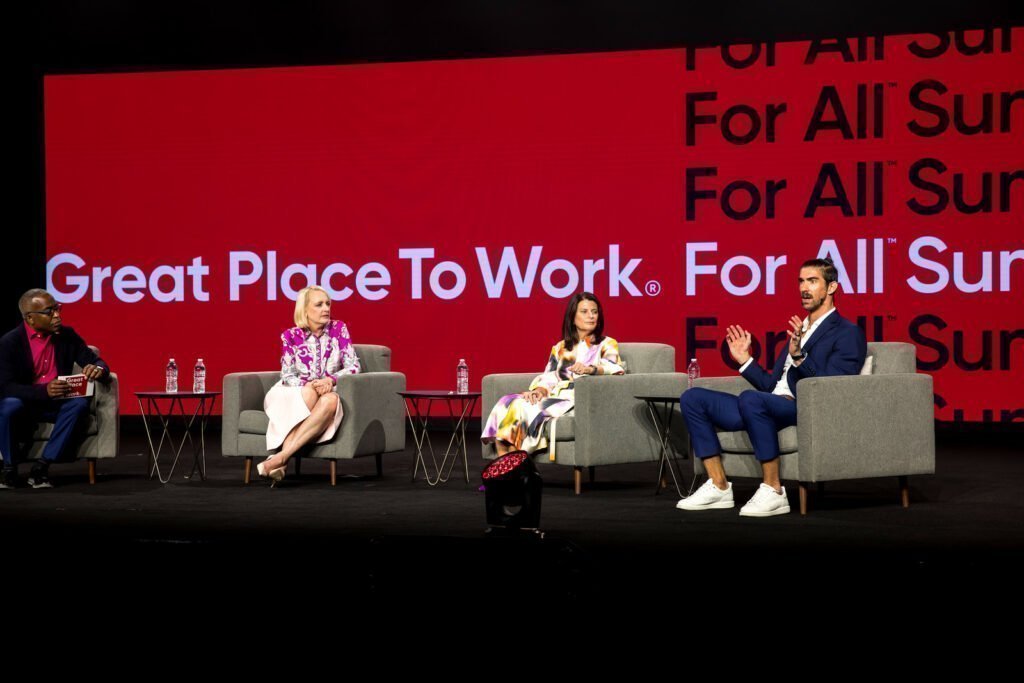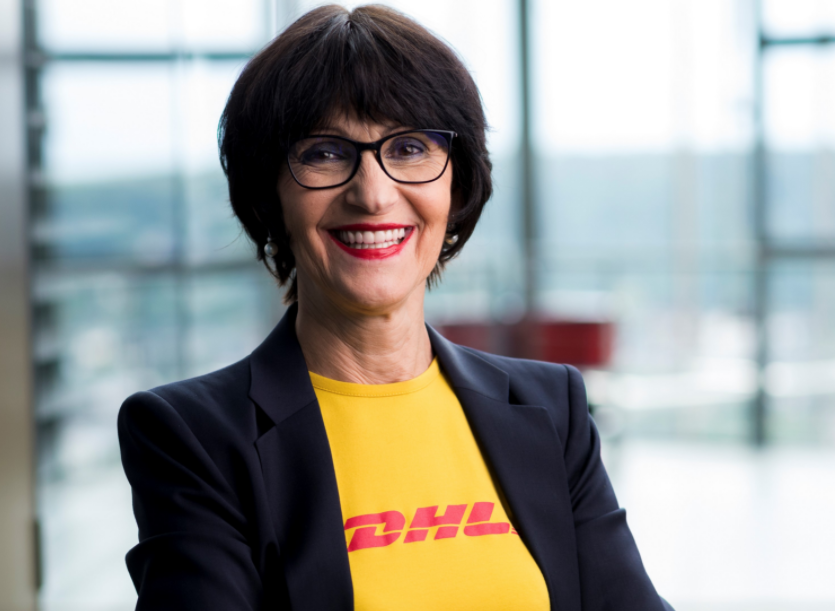by Jessica Levco
From left, Michael C. Bush, CEO of Great Place To Work; Julie Sweet, Accenture chair and CEO; Ellyn Shook, chief leadership and HR officer at Accenture; and Michael Phelps discuss the importance of mental health.
Attendees at the For All™ Summit learned the bottom line will only go up if you invest in improving the lives of your employees.
You can’t run your company through an Excel sheet.
“It takes commitment and courage,” said Julian Lute, senior strategic advisor at Great Place to Work®. “You want to create and nourish your community.”
On Oct. 13, speakers at the 18th annual Great Place to Work For All Summit showed how they nurture their employees. Here’s a look:
- Great companies want them to be great for all. For two years in a row, DHL Express is No. 1 among the World’s Best Workplaces™ in 2022. Thomas Ogilvie, board member for human resources and labor director at Deutsche Post DHL Group, said, “Every individual on our team needs to ask themselves: ‘Is DHL a great company to work for me?’”
- Go beyond listening. Although listening to employees is important, you must act on that feedback. “If employees tell us they need something, we try to do it within a week,” said Brian Doubles, president and CEO at Synchrony. “Listening is one thing, but acting on it is another. Close the loop.”
- Make wellness for employees a priority. Julie Sweet, chair and CEO of Accenture, talked about why wellness matters more than ever. “If you want to succeed in a tight labor market, well-being has to be an important priority for your company,” she said.
Advice like this resonated with first-time conference attendee, Jessica Koch, internal communications and engagement specialist at Lehigh Valley Health Network.
“The best part has been the passionate, knowledgeable people I met,” Koch said. “I’ve interacted with so many professionals who are driven to lead extraordinary change at their organizations. I’ve heard from remarkable leaders who have proven records of innovation and inclusion. I’m excited to bring my notes back home to help my organization continue to be a great place to work.”
THREE WAYS TO FOCUS ON THE EMPLOYEE JOURNEY
We spend so much time thinking about the customer journey, but why not bring that same level of care and intentionality to the employee journey? That was the question Pat Wadors, chief people officer at UKG, encouraged attendees to think deeply about.
“We think so much about what we want employees to do — sign up for benefits, set up their direct deposit, get a computer — but we need to focus on how we want them to think and feel,” said Wadors. “Stitching together the experience from their first day to final day at the company matters.”
Want to bring that level of care to your organization? Here’s how:
- Encourage nudging. Let’s say you’ve got a long hiring process and a manager has been talking to a college student who is about to take final exams. They might be interviewing at other places, but you want your company to stay top-of-mind. By using a technology platform, Wadors can send a reminder to the manager to encourage them to wish the future employee well on their finals and send a gift certificate for food.
- Don’t be late. The biggest turn-off for future employees is if the interviewer shows up late for the interview, Wadors says. Through an app, Wadors can find out if the hiring person was late. If they’ve been late for more than two interviews, they no longer get to be part of the interviewing process.
- Keep an eye out on your managers. Did you know that your boss has a huge role in your heart health? “Crappy managers can affect employees,” Wadors said. “Build and hire great managers, and give them the courage and leadership tools to be great.”
HOW TO BE YOUR AUTHENTIC SELF
Michael Phelps is more than an Olympic athlete. He’s dedicated to making the world a better place and shared his formula of success with attendees at the closing keynote address: Dream. Plan. Reach.
Attendees learned that there was a Phelps we saw on TV — the G.O.A.T. (Greatest Of All Time) who earned 28 Olympic medals, and an outstanding performer who defined what it meant to be a world class swimmer. But outside of the pool, he was a man who struggled with mental health issues including anxiety and depression.
In the fall of 2014, Phelps experienced the darkest time in his life and questioned whether he wanted to be alive. He decided he needed help and checked himself into a treatment center for 45 days. It was there he learned about himself: how to understand his emotions, communicate his feelings, and not to compartmentalize them.
He attributes the benefits of therapy to helping him understand who he is as a person and provide tools to help him manage his mental health, And in turn, it has made him a better version of himself as well as a stronger husband and father.
“For 20 years, I was carrying around 100 pounds of stuff,” Phelps said. “I had to figure out what self-care looked like and how to be my authentic self every single day.”
In 2008, he established the Michael Phelps Foundation, which works to promote water-safety, healthy living (physical and emotional wellness), and the pursuit of dreams.
During his transformation, Phelps stuck by these principles:
- Don’t feel guilty about self-care.
- Know who your special person is that you can talk to.
- Ask for help, but if you get rejected — it’s OK. “They just might not be able to help you in that exact moment,” he says. “There are people that I go to that sometimes will tell me they are not able to hold space for me at that time, and that’s okay.” Keep asking and you’ll find someone who has the capacity to help.
Phelps was joined onstage by Accenture’s Sweet, and Ellyn Shook, chief leadership and human resources officer, to talk about the importance of mental health in the workplace.
Shook encouraged us to ask those around us: “How are you doing? Really?” And then listen to the answer.
In meetings, she says, “Everyone’s like, ‘Oh, how are you?’ And then you jump right into your agenda, but you never really pause to see or hear how the person is really doing.”
Mental health is a top priority in managing the firm’s 700,000+ employees—from leaders to individual contributors to everyone in between.
“I think for all of us, just to understand that the person, whether they’re a high performer or not, on the other side of you, may be going through something profoundly difficult and you may never know,” Sweet said. “And it could be the least likely person in your mind. Ask those around you: “How are you doing? Really?” And then listen to the answer.”
— Ellyn Shook, chief leadership and human resources officer, Accenture
Not only did Accenture listen and act on company data that showed mental support was needed, it’s become a prominent voice in normalizing mental health as a priority in the workplace.
Shook spends a lot of time thinking about how to infuse empathy into our day-to-day at work.
“How do we help people think, ‘Oh, that person could be having a tough day. They might need help,’” she said.
Building on what Sweet said, Shook added: “It’s about the human connection and creating the conditions for care, kindness and connection. [That’s] really the place in the journey we are today.”
Shook described “a little experiment” she conducted ahead of a global management committee meeting. She spent two weeks writing personal letters to each member and had those letters waiting for them when they checked into their rooms. She shared the ways in which she admired them and their families. The response, she said, was “extraordinary.”
“What I think it showed each one of us is when you see someone as a human being first — not as an employee, not as one of Fortune’s most powerful women — but as an employee, a human being, that makes a big difference to people,” she said. “And that is how you can achieve what it is we’re trying to achieve one person at a time, even when there’s 721,000 of us.”






